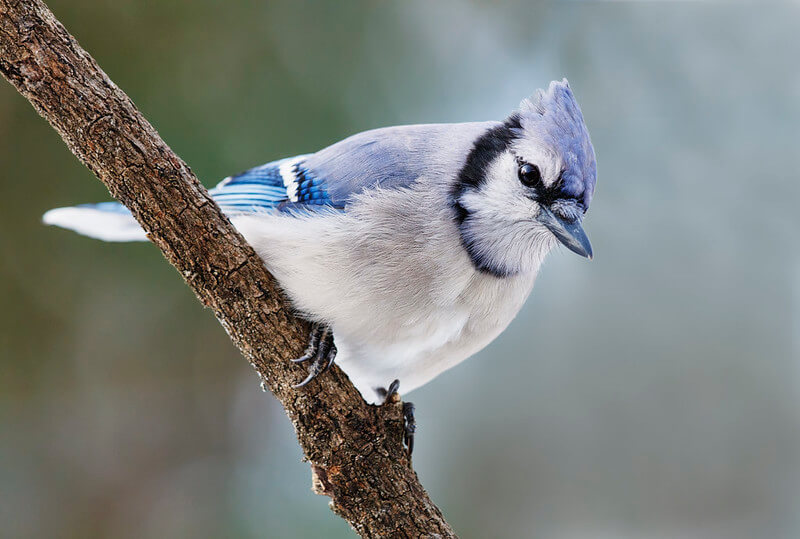Consoling Presence
By Peggy Mallette
Broadcast 12.28 & 12.31.2022

A blue jay perches on a branch. Photo by N. Lewis, National Park Service photo, public domain.
Listen:
I’ve always loved looking at birds but I had never experienced a deep connection with one. Birds were something to observe and enjoy, an activity on my like-to-do list. But all that changed on Saturday, December 19th, 2020, when a single Blue Jay entered my life for a fleeting five minutes.
My husband was diagnosed with Covid-19 that week. His symptoms progressed rapidly and after a week of caring for him, isolated from each other in the house, I had to drive him to the hospital. I was forced to deposit him in the ER waiting room and walk away while he huddled in a wheelchair clutching his portable oxygen tank.
I woke up the next morning in our silent, empty house alone on my pandemic island of anxiety. Desperate for solace I walked outside and sat on a stump in the backyard that cold December morning in an aspen grove shadowed by ponderosa pines and bare-branched serviceberry bushes. Nature has always been my refuge but I was so absorbed in my grief that I could hardly see it, let alone experience its healing power.
Suddenly a beautiful Blue Jay alighted on a low branch barely three feet away. This medium-sized bird is known for its raucous calls, thievery, and aggressive behavior, but this one moved close to me and silently remained near me for a full five minutes. Its bright blue jacket and head crest stood out in the stark, gray light. We sat looking at each other. I told it of my suffering and it sat still on its perch as if listening intently. In its quiet presence my anguish receded until I had calmed, feeling drained and open to the world again. Since that experience I have wondered—was that real? Are Blue Jays capable of empathy?
I wanted to learn more about my Blue Jay friend and found that seeing one in my backyard in western Montana was surprising. They live mostly east of the Rocky Mountains. That bright blue color is also surprising since it comes from a pigment called melanin, which is brown. The beautiful color that captivated my teary eyes is caused by the scattering of light through modified cells on the surface of the feather barbs.
Blue Jays are a member of the corvid family, which includes crows, ravens, and magpies, and though they look different, they share some of the same intelligence and resourcefulness. Ornithologists have investigated whether ravens feel sympathy in a study that looked at consoling behaviors. The act of consoling means recognizing suffering in another and then responding in a way that helps alleviate that suffering. They studied 13 young ravens in a family group for two years. Fights between a family member and an outsider can be prolonged and ugly. The researchers discovered that within two minutes after an intense conflict flock members offered consoling gestures to the victim of the fight—sitting next to it, preening it, twining bills, and touching the victim’s body gently with their bill while making soft comforting sounds. Among their conclusions was the suggestion that ravens may be responsive to the emotional needs of other ravens.
While it remains unknown whether birds can truly feel empathy for others of their kind, let alone for humans, more scientists seem willing to admit the possibility. I realized, however, that it really doesn’t matter. I know that thanks to the unusual actions of that single Blue Jay my suffering was reduced. When it finally flew to the top of a tall ponderosa I felt an abundance of gratitude and a deeper connection to all living beings. Thankfully my husband was released from the hospital after 10 days, just in time to celebrate a new year and a fresh appreciation of life.
Every week since 1991, Field Notes has inquired about Montana’s natural history. Field Notes are written by naturalists, students, and listeners about the puzzle-tree bark, eagle talons, woolly aphids, and giant puffballs of Western, Central and Southwestern Montana and aired weekly on Montana Public Radio.
Click here to read and listen to more Field Notes. Field Notes is available as a podcast! Subscribe on Apple Podcasts or wherever you listen to podcasts.
Interested in writing a Field Note? Contact Allison De Jong, Field Notes editor, at adejong [at] montananaturalist [dot] org or 406.327.0405.
Want to learn more about our programs as well as fun natural history facts and seasonal phenology? Sign up for our e-newsletter! You can also become a member and get discounts on our programs as well as free reciprocal admission to 300+ science centers in North America!












